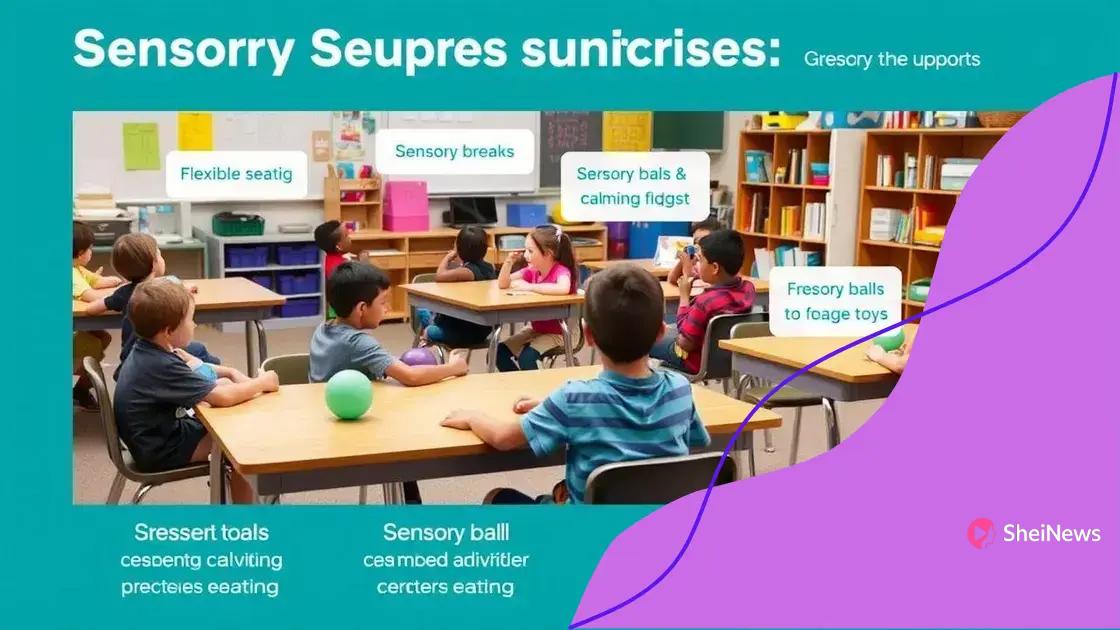Supporting students with sensory sensitivities effectively

Anúncios
Supporting students with sensory sensitivities involves implementing sensory-friendly strategies, fostering collaboration among parents and professionals, and creating inclusive environments that cater to diverse sensory needs in the classroom.
Supporting students with sensory sensitivities is essential in fostering an inclusive learning environment. Have you ever wondered how these sensitivities impact classroom experiences? Let’s dive into effective ways to address these needs.
Anúncios
Understanding sensory sensitivities in students
Understanding sensory sensitivities in students is a crucial aspect of creating an effective learning environment. Many students experience the world differently due to their sensory processing, which can affect their focus and interactions in the classroom.
The Importance of Recognizing Sensory Sensitivities
Recognizing these sensitivities is the first step toward providing the right support. When teachers understand how sensory sensitivities manifest, they can better tailor their teaching strategies.
For instance, a student may become overwhelmed by bright lights or loud noises. This can lead to distractions and difficulties in concentrating on lessons.
Anúncios
Key Examples of Sensory Sensitivities
- Visual sensitivities: Some students may find fluorescent lighting uncomfortable, leading to headaches or anxiety.
- Auditory sensitivities: Background noise can be particularly challenging for students who are sensitive to sound.
- Tactile sensitivities: Clothing tags or certain fabrics may cause discomfort or irritability.
- Olfactory sensitivities: Strong smells from food or cleaning products can distract or upset some students.
By becoming aware of these specific sensitivities, educators can adjust their environments. This might mean allowing students to wear sunglasses in class or providing noise-canceling headphones.
Creating a classroom space that acknowledges and accommodates these different sensory needs helps foster inclusion and promotes a positive learning atmosphere for all students.
Creating a sensory-friendly classroom environment
Creating a sensory-friendly classroom environment is essential for supporting students with varying sensory needs. The layout, colors, and tools used in the classroom can significantly impact how students engage and learn.
Elements of a Sensory-Friendly Classroom
First, consider the physical space. Soft lighting can help reduce glare and tension, making the atmosphere more comfortable. Utilizing color schemes that are calm and neutral can also help students feel at ease. A clutter-free environment minimizes distractions, allowing students to focus better on their tasks.
In addition to the physical setup, it’s important to incorporate sensory tools in the classroom. Items like fidget spinners, stress balls, and textured materials can provide the necessary stimulation some students seek, helping to manage their sensory needs.
Creating Quiet Spaces
Another vital aspect of a sensory-friendly classroom is having designated quiet areas. These areas should be cozy and secluded, offering students the chance to retreat when feeling overwhelmed. Incorporating bean bags, cushions, or even tents can create a safe haven.
- Cozy corners: Use soft seating and calming visuals.
- Noise-canceling headphones: Make them available for students who need to minimize auditory distractions.
- Sensory breaks: Schedule time for students to engage with sensory tools or relax in the quiet area.
Ultimately, creating a sensory-friendly environment means being observant and responsive to the needs of all students. By providing a space that accommodates sensory sensitivities, teachers can foster a more inclusive and engaging learning experience.
Strategies to support students with sensory needs

Strategies to support students with sensory needs are vital in creating an inclusive classroom. These methods can help tailor the learning experience to meet diverse sensory requirements, ensuring every student has the opportunity to thrive.
Implement Sensory Breaks
Allowing students to take sensory breaks during lessons is essential. These breaks help students reset and manage overwhelming feelings. Simply stepping away from the busy classroom to a calm space can do wonders.
- Schedule regular breaks: Plan specific times during the day for sensory breaks.
- Utilize calming tools: Provide resources like stress balls or fidget toys during breaks.
- Create a quiet zone: Designate an area where students can relax and recharge.
In addition to sensory breaks, it’s important to modify classroom activities. Different students have varying sensory inputs that work best for them. For example, some may thrive with tactile activities, while others may need more visual aids.
Incorporate Flexible Learning Options
Giving students choices in how they learn can significantly enhance their educational experience. This flexibility can include options for seating, such as standing desks or bean bags. Incorporating technology like tablets can also be beneficial, allowing students to engage with materials in their own way.
Moreover, encouraging students to provide feedback on their sensory needs helps build an inclusive environment. This practice not only empowers students but also enables teachers to make informed adjustments. Small changes can lead to better focus and improved learning outcomes.
Ultimately, supporting students with sensory needs means being adaptable and willing to explore various strategies. By fostering an understanding and accommodating classroom, educators can enhance learning for all.
Collaborating with parents and professionals
Collaborating with parents and professionals is essential for effectively supporting students with sensory sensitivities. Building a strong partnership helps create a consistent approach to addressing each child’s unique needs.
Engaging Parents
Parents know their children best, so their insights are invaluable. Regular communication with families can reveal what works at home and what might help in the classroom.
- Share observations: Teachers should share what they notice about a child’s behavior and performance.
- Listen actively: Take the time to understand parents’ concerns and suggestions regarding sensory needs.
- Set up regular check-ins: Schedule meetings to discuss progress and strategies together.
Involving parents in decision-making not only boosts their confidence but also helps tailor interventions to fit their child’s specific requirements. This relationship fosters a seamless transition between home and school.
Working with Professionals
Collaboration with professionals, such as occupational therapists or school counselors, is also vital. These experts provide strategies and support that can enhance classroom practices.
For instance, teachers can work with an occupational therapist to design specific sensory activities tailored to a child’s needs. Additionally, seeking input from special education specialists can lead to effective accommodations within the classroom.
Having a multidisciplinary team ensures all aspects of a student’s development are considered. When teachers, parents, and professionals work together, they create a holistic support system that can significantly improve a child’s learning experience.
Promoting awareness and understanding in schools
Promoting awareness and understanding in schools is crucial for supporting students with sensory sensitivities. When teachers, staff, and students recognize these needs, they can create a more inclusive environment.
Building Awareness
One effective way to promote awareness is through training programs. Educators should participate in workshops that focus on sensory sensitivities and how to identify them in students. Understanding the signs can lead to better support.
- Workshops: Organize sessions that inform staff about sensory sensitivities.
- Information sessions: Host meetings where parents and families can learn together.
- Resource materials: Provide easy access to brochures and guides on the topic.
In addition to formal training, incorporating sensory education into the curriculum can raise awareness. Teaching all students about sensory processing can foster empathy and understanding.
Involving the School Community
Creating a culture of understanding often requires the involvement of the entire school community. Encourage students to discuss their sensory differences with peers. This practice not only clears misconceptions but also normalizes conversations about sensory needs.
Additionally, celebrate events that focus on diversity and inclusion. Activities like awareness weeks can bring attention to the topic while engaging the student body.
By embracing a proactive approach, schools can create an environment that respects and accommodates sensory differences. This commitment to education and awareness ultimately creates a safer and more supportive space for all students.
FAQ – Supporting Students with Sensory Sensitivities
What are sensory sensitivities?
Sensory sensitivities refer to the heightened or altered responses some individuals have to sensory input, which can affect their behavior and learning.
How can I create a sensory-friendly classroom?
You can create a sensory-friendly classroom by using soft lighting, providing calming tools, and establishing quiet spaces for students to retreat when overwhelmed.
Why is parent collaboration important?
Collaborating with parents helps to gather insights about a child’s needs and encourages a consistent approach between home and school.
What strategies can support students with sensory needs?
Strategies include implementing sensory breaks, using flexible seating, and incorporating sensory-friendly tools and activities.





